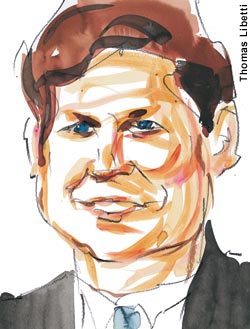Zealot Profile: Wade R. Fenn
Best Buy Co. Inc., Executive Vice President, Marketing
(originally published by Booz & Company)Best Buy is a fast-growing national retail chain specializing in consumer electronics, personal computers, entertainment software, and appliances. With more than 400 stores in 41 states, the company is expected to generate $15 billion in revenues this year, slightly more than its closest rival, Circuit City Stores Inc. Best Buy has boosted sales by 50 percent since 1998. A far-reaching cost-reduction program, initiated by marketing EVP Wade Fenn, lifted profits 3.5 times during the same period. Best Buy hopes to become a major e-commerce player, and plans to offer all its store products online at www.bestbuy.com within the next year.
 “My vision for Best Buy is to make the transition from being a place where you buy products to a place where you get connected digitally. Our mission statement says Best Buy is ‘at the intersection of technology and life.’ We need to take all this technology and help the customer make the most of it. For instance, you can buy a wireless phone that has capabilities most people don’t even realize are there, or don’t know how to use. My cell phone beeps twice a day and gives Best Buy’s stock price. Most consumers don’t know how to set that up. What if your phone could page you as soon as your child arrives home from school? That’s in the future.
“My vision for Best Buy is to make the transition from being a place where you buy products to a place where you get connected digitally. Our mission statement says Best Buy is ‘at the intersection of technology and life.’ We need to take all this technology and help the customer make the most of it. For instance, you can buy a wireless phone that has capabilities most people don’t even realize are there, or don’t know how to use. My cell phone beeps twice a day and gives Best Buy’s stock price. Most consumers don’t know how to set that up. What if your phone could page you as soon as your child arrives home from school? That’s in the future.
“We need to do more customer profiling and give customers better information and advice about how to use products so they get the most benefit from them. Providing complex solutions is clearly a lot more than just selling them a product. Five years ago, we were working on the plumbing of the company. Now, we’re focusing on selling connections and applications and content to consumers. Part of what makes us unique is that 71 percent of our customers are already online. They want technology in their lives. Our strategy is not mass market, but it is not boutique either. We are mass specialists.
“My priorities change frequently because the world we live in changes quickly. I set them based on looking at a combination of internal and external situations and saying: ‘How do we stay ahead?’ Of course, we can’t always be infinitely flexible, especially with initiatives that require two- or three-year commitments.
“For instance, we saw what America Online and Gateway were doing with joint marketing. We also saw that our customers needed a portal connectivity strategy, so we established a relationship with Microsoft to jointly promote each other’s products. We were somewhat reactive, but our company is able to move quickly. We said we’d acquire a million customers a year with Microsoft, and we’re on track to exceed that.
“We’ve been steadily reengineering our internal processes since 1997. It’s one reason we’ve raised our gross margins more than 500 basis points and ramped up revenue per store with significantly less inventory.
“I wouldn’t call my decision-making process democratic or autocratic. But occasionally I’ve had to be authoritarian. One example involved a process change program called Process to Profits. A lot of people feared it would not be good for the relationships with vendors. Many wanted to go back to where we were comfortable. I said, ‘No, we’re going down this road.’ In fact, our satisfaction scorecards with vendors went up because we were operating with facts, not guesses. With better estimates of demand, our vendors could be more responsive and profitable.
“How do you make sure your ideas are implemented? Surround yourself with a lot of good people who know how to manage well. When you have good people, less follow-up is needed, because ideas are generated by and are owned by people several levels below senior management. And keep a keen eye on real business results. Denial is our greatest enemy when living in an environment where customers and markets change quickly.
“I’ve been at Best Buy for 20 years. My career outside of this company once I graduated from college lasted about 90 days. Sometimes I’ve been too internally focused; other times too externally focused. It’s hard to get a balance. At times people in the company have felt alienated because I wasn’t paying enough attention to fostering relationships. Balancing our speed and desire for change with the practical realities of developing people, processes, and systems is our toughest job. ![]()
| Authors
Victoria Griffith, Griffgor@aol.com Victoria Griffith writes about technology and management for the Financial Times and other publications. She has an MA in international politics from the Johns Hopkins School of Advanced International Studies. Ms. Griffith is based in Boston. |

